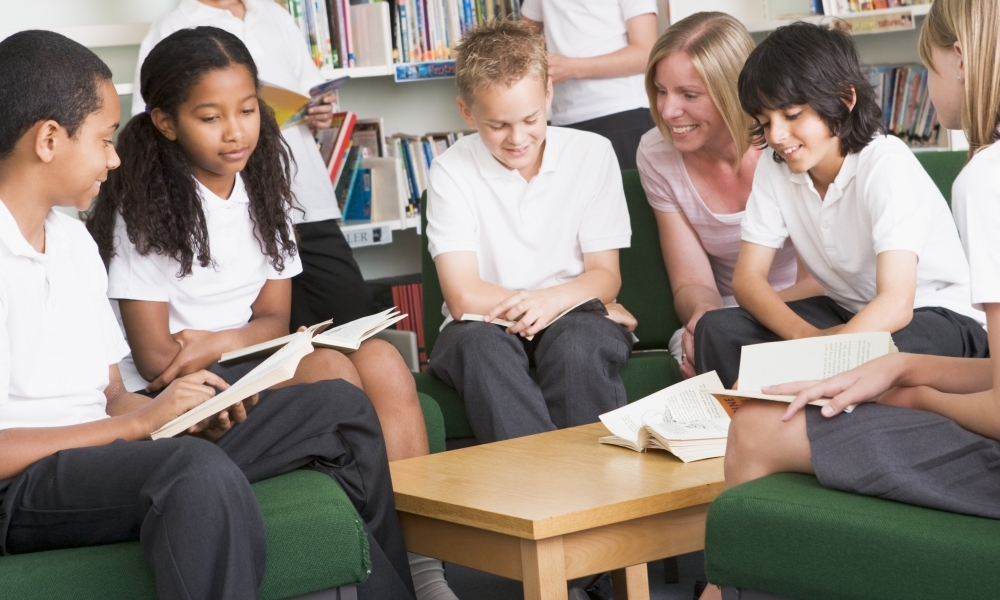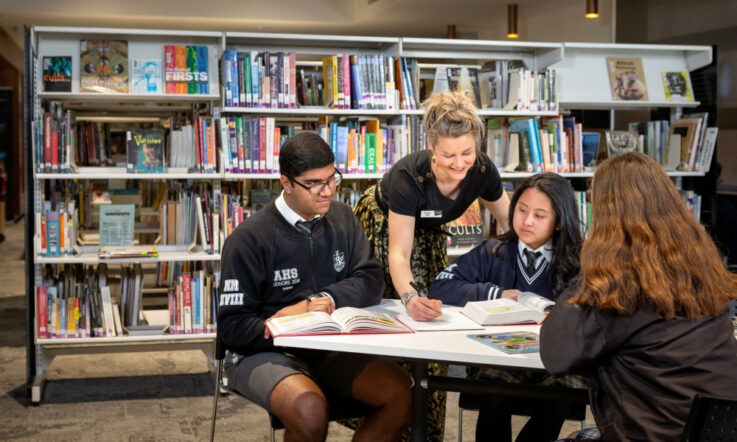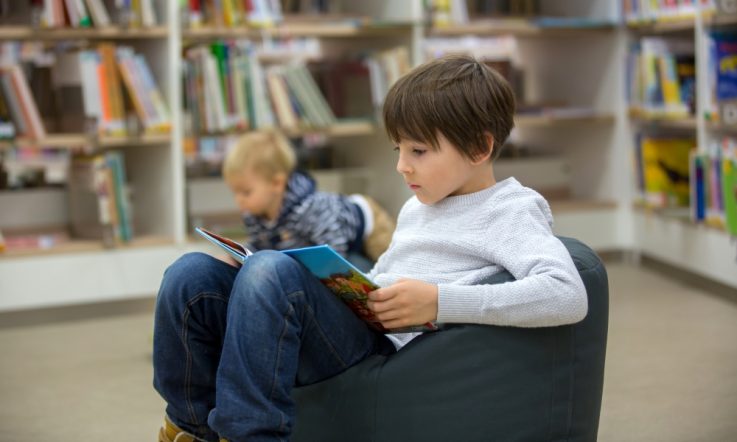This podcast from Teacher is supported by Charles Sturt University’s Master of Education (generic and with specialisations). Flexible online study that suits your life.
Hello, from Teacher magazine I’m Jo Earp and welcome to another episode of The Research Files. We recently brought you news of an Australian study showing that having a qualified teacher librarian on staff is associated with improved student literacy outcomes. Those findings stem from a 2019 census commissioned by the School Library Association of South Australia and carried out by a team from the Australian Council for Educational Research. The wide-ranging survey collected data on school library staffing, facilities, funding, and support, and as you’ll hear, researchers also carried out a review of every school website. The findings have been published in the report School libraries in South Australia: 2019 Census. Lead author, ACER Senior Research Fellow Dr Katherine Dix, is my guest today. We’ll be discussing the importance of school libraries, some of the different models being used by schools, provision in primary and secondary, and in different locations, and the connection (or disconnection) between the value leaders place on their library and its representation on the school’s public-facing website. Let’s get started.
Jo Earp: Hi Katherine, welcome to the Research Files. This 2019 census, that reached right across the state, and across the school sectors as well – so, government, Catholic and independent. How many were involved in total?
Katherine Dix: In South Australia we actually have 730 schools, approximately, and we wanted to get to all of them in order to provide, for the first time in Australia, a really clear understanding of the status of school library services. We did this through an online survey census, backed up by desk review of the school websites themselves.
JE: And it was unique in the sense that it was actually targeted at school leaders, wasn’t it? Why did you target it at school leaders, rather than, say, teacher librarians?
KD: A lot of the challenges from previous surveys that have been done on school libraries have focused on the teacher librarian and, as you know, not all schools have teacher librarians. So, immediately you get the challenge where schools don’t think that they’ve got a teacher librarian on board so this survey is not for them.
So, by focusing it at school leadership, in general, we were hoping to reduce non-response bias (is what it’s called) – so, when participants don’t complete surveys because it’s missing the mark or they don’t feel like the survey is for them. And because we took the census approach we actually wanted every school to participate and we didn’t want to make any assumptions around who mightn’t be filling out that survey. It could be a volunteering parent that’s filling out the survey because they’re in charge of the library, and we also know that some schools don’t even have libraries – so, you know, who does the survey go to then?
JE: That’s interesting, we don’t talk about the targeting of surveys too much on Research Files, but that’s an interesting insight there into the decision making around that. So what does the existing research say about school libraries? Why is having a school library important?
KD: There’s a lot of evidence that has come out of those previous surveys to show the links between students’ literacy skills and the importance of libraries and librarians. So, having a qualified teacher librarian in a school really strengthens the school’s capacity to build that love of reading. Libraries themselves can provide a very strong, safe place for some students, when other areas of the school may be not so friendly (if there’s bullying etcetera happening in the school).
So, quite often schools refer to their libraries as the ‘heart of the school’, it’s a hub where lots of different activities happen that bring the school together as a community and across the school, rather than just being isolated in the different classrooms. So, we were really interested in finding out to what extent do schools actually have libraries these days, what do those libraries look like in terms of their levels of access to technology, and also in terms other elements, like, are they maker spaces?
These days there’s a lot of push for libraries to become so multi-purposed, it’s sort of hard to see: what are they doing in the library section alone? It’s one of those spaces that can be quite easily encroached upon. And so, one of the things we did find out from this survey was that school libraries themselves were feeling that pressure to do more things, actually leaving less space for them to actually do their core purpose, which was to provide literacy and reading resources for the school.
JE: You mentioned there the term ‘qualified teacher librarian’ right at the start of your answer and we’ll talk about that in a moment. The other thing is: what is the definition of a library, what are schools saying libraries are in their context, and that’s something we’ll talk about too. So, I want to go through some of the headline findings from this census then. Firstly, what did you find about the existence of school libraries (and a reminder this is in South Australia) and who they’re staffed by?
KD: The model of library provision itself was extremely diverse. So, again, we wanted to come in and be as inclusive and open as possible in terms of what schools mean by providing library resources. They can range from anything from a traditional, centralised serving of resources, of books and technology etcetera, right through to a completely blended environment where there’s a lot of resources online, and some have gone completely online – so it’s just all up in the cloud, you have a portal that you go through and you can get access to those reading resources and other information sources.
Around six per cent of schools in South Australia do not have a library, with half accessing mobile or community libraries. So, again, South Australia provides those additional challenges. Because we’re such a distributed society, we’ve got lots of remote and rural communities and they don’t have the funds and sourcing of resources to be able to have their own libraries, so sometimes they need to take advantage of those mobile libraries.
A lot of the schools also make use of the local community library, and some of those are joint libraries – so, the library is jointly managed by both the community and the school themselves, and they have optional opening hours so that the public can come of the library after school hours, but the school itself gets access to the library during the day.
JE: So that would be about 94 per cent of schools that do have a library. Who did you find that they were staffed by?
KD: Only 23 per cent of school libraries are staffed by a qualified teacher librarian, so that means the rest are staffed by librarians but they’re not teacher librarians, or they’re qualified SSOs [School Support Officers] or non-qualified SSOs. So, yeah, only 23 per cent, which I think is quite indicative of the challenges that this section of the education space is having.
And we know that there is a lot of concern from the teacher librarian cohort out there that even getting their jobs from year to year is getting increasingly hard, because funding can sometimes take a hit and often it’s the school library that seems to be the one that bears the brunt in reduced funding for purchasing books, reduced funding around staffing the library appropriately etcetera.
What’s really interesting is that there almost seems to be a direction, a trend where schools by design are not building in dedicated library spaces – they’re coming up with these distributed models where they might have a shelf here on that floor and a shelf down there on that floor, or the resources, the reading resources, are actually located back in the classrooms and not centrally managed.
So, when those sorts of scenarios happen you don’t have that core person that’s really focused on making sure all of the community is served best by the resources that are available; the community can’t be brought up to date as to what best approaches and technology resources are out there. So, a qualified teacher librarian is such a value-add to a school in terms of the additional capacity that they bring, above and beyond other curriculum areas. So, to not have one I think is a disservice to the school community, potentially.
JE: You said there are 23 per cent that only have qualified teacher librarians and just reading in the report here: 51 per cent of managing staff are not library qualified; 36 per cent are managed by SSOs (that’s School Support Officers), or Education Support Officers, and they’ve got no library or teaching qualifications.
KD: Yeah, so they obviously go through the processes of managing resources but there’s not that ability to really advocate for what they’re doing and why it’s important. So that, I think, is an increasing concern, and the smaller that voice gets the easier it is to ignore it I guess.
JE: Having been a teacher myself, having that expertise there – in the shape of a qualified teacher librarian – is important for classroom teachers and colleagues to call on. There’s such a wealth of expertise and information there from people in that role.
KD: And quite often … I mean, the school in itself is there to help support particularly low socioeconomic communities that may not have easy access or a sense of importance around literacy and reading. You know, they might not often as a family visit the local community library. So, you know, this is where libraries really come into their own, in terms of exposing children to books, giving them the opportunity to find books they love, and really start to develop that love of learning and reading really.
JE: We’ll find out more about some of the common library models in schools and the value leaders place on their school library, after this quick message from our sponsor.
You’re listening to a podcast from Teacher magazine, supported by Charles Sturt University’s Master of Education (generic and with specialisations). As Australia’s most experienced online university, at Charles Sturt you’ll get the freedom to combine study and work so you can advance your career. Develop your leadership capabilities through specialist education expertise. Search Charles Sturt Master of Education to find out more.
JE: Welcome back, I’m here with Dr Katherine Dix. You collected lots of data in the census, about the facilities and resources. We mentioned earlier about some of the library models and we touched briefly on that; I’m really interested to dig down a bit deeper into what some of those common models are for schools in South Australia.
KD: Yeah, it’s a challenge again, very diverse and it’s sort of a mixed combination of all these different elements. But, in general, we found that around three quarters of schools followed a traditional format that provided access to a physical on-site library space, and usually this was equivalent to at least two standard classrooms [in size], with some providing additional books distributed throughout the school but they do not substantively use online resources. So this is that really traditional, centralised model, technology is kind of there but it’s not a central part of information, and these actually tended to be primary schools. And you can imagine, picking up books, reading books, opening them, that kind of thing, where students’ technology skills are still developing the ability to go and learn how to go and find a book and learn from it is still really important as a skill.
About 13 per cent of libraries had a blended model of access to both physical and virtual catalogue resources. These tended to be large secondary schools in high SES metropolitan areas. So, you’re starting to see distinctions between types of schools and the libraries that serve them.
We also found that those combined, smaller K-12 area schools were less likely to have on-site libraries. So, basically they had no dedicated library space but they had access to other options such as community libraries, joint libraries and mobile services. And in one or two cases they had pop-up libraries, which I thought was quite nice, you know, bush libraries.
The larger schools did tend to have more dedicated space than smaller schools, as you could imagine, and the high socioeconomic status schools and secondary schools in metropolitan locations tended to have more space than the low socioeconomic status schools and special schools or schools located in non-metropolitan regions.
So, yeah, I found it still quite compelling that some of the large high schools though don’t actually have libraries. So, if the school doesn’t already value having a teacher librarian and doesn’t involve them in the consultation of a design of the school, then that voice isn’t getting heard at all. So, you know, the likelihood of a school being developed without one is increasing, I think, because we know that there are fewer teacher librarians graduating and a diminishing number of positions for them.
JE: So, there are lots of sections in the report, and I’ll pop a link to it in the transcript of this podcast on the Teacher website so people can have a look through all the findings in detail. There’s a section on technology, what did you find?
KD: Over 90 per cent of schools have the usual features like library shelving, quiet reading areas etcetera, but many of them also have use of technology and access to technology. And I think that’s been sort of more crucial than ever during the COVID-19 pandemic and the need for students to actually do online learning and work from home. And keep in mind this census was done at the end of 2019, so before COVID-19 had hit, and we saw over that period when schools had to go online and deliver their learning online there was challenges in some communities about getting access to that technology – so, laptops, you know, having children set up. So I think that’s really probably pushed things forward, both for libraries as well in terms of that engagement with technology.
Eighty-six per cent of schools, we found from the census, had networked resources with laptops or tablets that can be used in the library. However, just over half had a desktop computer in the library or computer hubs for information access and to search the web. So, again, there are those different models of have they got a fixed hub still, that kind of model, or is it a school that has BYO device, you know, so the students can come into the library and access resources or actually they can be anywhere in the school and still access those online resources.
JE: One of the other sections that I found fascinating was the one on the culture of support for the library in a school – so, what kind of value do leaders place on it and what kind of value does the school community place on it? What did you find there in terms of leadership responses, and how they compared with the review of the websites, because what you actually did was you had a look at all of the public-facing websites of the schools to see if the library was flagged up on those didn’t you?
KD: Absolutely, this was just a different element I wanted to take. Because we were doing a census survey, I thought wouldn’t it be interesting to find out to what extent were schools’ views of their library reflected on their actual public-facing website.
So, yeah, we sat down and went through all 730 websites and came up with a bit of a ratings system. So, if you went to a school website page and there on the front page was a button to the library, you know, navigation straight to the library, that got the highest mark so to speak, the highest score; it took you through to a dedicated library page and you could see it was Book Week, it was all of the activities, their opening hours, lots of rich information. And you just got a sense that this was really a central part of the school, you know, and that they were proud of it and it was up there front and centre alongside their sporting activities and their curriculum etcetera, it was held in pride of place.
It went all the way through to trying to even find evidence of a library, which something might appear in a school context statement, there was a budget line for library, and there was everything in between. And, on the basis of rating a school’s library presence, we were able to then compare that to the survey results themselves to see if there was a relationship. And, basically, schools that had a high visibility of their library, [it was] more strongly valued by school leadership and by staff. So there was definitely a correlation, a relationship, between the amount a library was made visible on a school’s website to the public community, and the way the school actually viewed their library as a resource and something to be proud of.
It’s quite interesting in that, I mean, every principal’s tour of a school, they’ll always take you through the library (assuming they’ve got one), and it’s like a core central place of learning and engagement. And yet, so many schools don’t promote that on their website, you know, it’s lost down in a subsection of a page. So, sometimes it was really hard to find any evidence at all, and obviously there were those schools that we were able to match up with their survey responses that said ‘no, we don’t have a library’ and, literally, there was no evidence of that on their website. So there was a good agreement between those sorts of reports.
The website also helped us to fill in some of those gaps. So, not every school fully participated in the survey, doing every question, but we did follow up with schools that didn’t submit a survey and asked them a handful of high level questions and also back-filled some of that information with the evidence that we found in the library search of websites. And that’s how we achieved census, which I think was really important, and can stand on the results to say that ‘this is really a very strong and clear picture of what’s going on and it’s not subject to non-response bias that you might get through some of those other surveys’.
JE: Absolutely. So, that’s interesting to hear that those schools that said that they valued their library really did ‘walk the walk’, as it were, that’s pleasing. Finally then, it’s quite hard to sum up I guess, but what are some of the major implications of this census data – not just for South Australia, which is where you did the research, but other schools and school libraries right across Australia.
KD: Yeah, sure. What is clear from this and other research in Australia is that there is challenging times ahead, particularly for the diminishing number of opportunities for qualified teacher librarians. When school budgets are insufficient, it’s often the qualified teacher librarian who is replaced by an unqualified teacher or SSO. When schools exceed capacity, it is often the library that is encroached upon or converted for other purposes.
More worryingly is the growing trend that new schools are being built without a library, by design, without consultation with a qualified teacher librarian during the design stage. For example, there’s the $225 million Arthur Phillip High School in New South Wales, [which] has iHubs for each level on different floors, rather than a dedicated centralised space, in the form of a traditional library, where students can be assisted to find books they love or find calm in a quiet, comfortable area, to read them.
JE: So, as I’ve mentioned, there’s plenty from this census for listeners to look into – we’ve just touched on a few of those findings and I’d definitely recommend having a look at the full report. A reminder that it’s called School libraries in South Australia: 2019 Census. Dr Katherine Dix, it’s been so interesting speaking to you today, thanks for sharing your findings with The Research Files.
KD: Thank you very much for having me.
That’s all for this episode. If you want to keep listening, there are more than 60 episodes of The Research Files, and more than 170 in total in our podcast archive. It includes Research Files Episode 53: Building a school reading culture, where Dr Margaret Merga shares details of her study of teacher librarians’ perceptions. In this snippet she gives one piece of advice for educators wanting to develop and enhance their school reading culture.
Well the first thing that ideally can be done is the engagement of leadership support. If you don’t already have your leadership onside, make them understand the importance that they can wield in their position as a leader in the school through acting as a model and advocate for reading, for being present. So for example, one of the teacher librarians in the study described a previous leadership that came in to the class and read to the first grade students during Book Week and the impression that this made on young people about the importance of reading. So it’s really important to get the leadership on side.
You can find the full episode on the Teacher website or wherever you get your podcasts from. Don’t forget to hit the subscribe button on your podcast app to keep up to date with the latest from Teacher magazine, and please rate and review us while you’re there.
You’ve been listening to a podcast from Teacher supported by Charles Sturt University’s Master of Education (generic and with specialisations). Search Charles Sturt Master of Education to find out more.
References and related reading
Baker, J. (2020, January 31) Sydney's new $225 million school has 17 floors, but no library. Sydney Morning Herald. https://www.smh.com.au/national/sydney-s-new-225-million-school-has-17-floors-but-no-library-20200131-p53wiy.html
Dix, K., Felgate, R., Ahmed, S., Carslake, T., & Sniedze-Gregory, S. (2020). School libraries in South Australia: 2019 Census. Australian Council for Educational Research. https://doi.org/10.37517/978-1-74286-583-6
As a school leader, do you provide a centralised space where students can be assisted to find books and resources?
Do you publicly promote this resource as a valued asset of the school? Does the library have a dedicated area on the school website?



